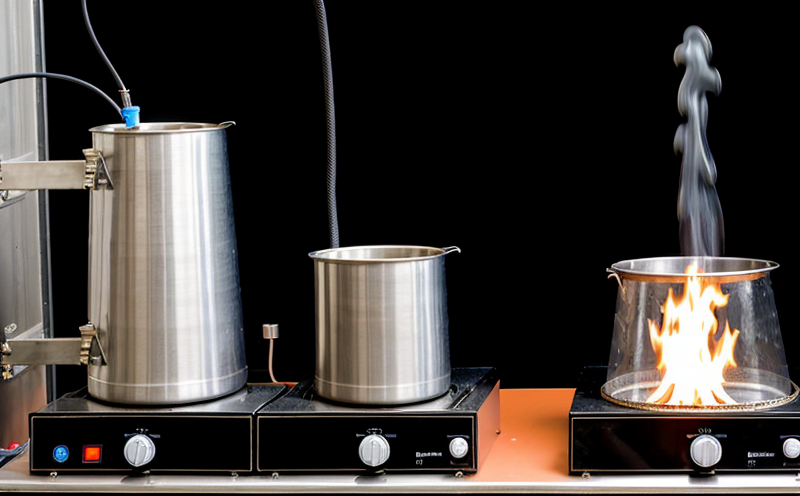Heat Release Testing of Building Materials
In today’s rapidly evolving construction industry, ensuring safety and compliance is paramount. Heat release testing plays a crucial role in evaluating the flammability characteristics of building materials. This testing method assesses how much heat energy is released during combustion and measures smoke production rates.
This test helps identify materials that can contribute to fire spread and potential damage within structures. By conducting thorough heat release tests, we ensure that only safe and reliable products reach the market. Compliance with international standards like ISO 56602 and ASTM E1354 ensures consistent quality across different regions.
The testing process typically involves subjecting a representative sample of building materials to controlled combustion conditions under specified parameters. The apparatus used includes calorimeters designed specifically for measuring heat release rates, smoke production indices, and other relevant metrics.
During the test, we monitor various factors such as temperature rise, oxygen consumption, and carbon dioxide levels in real-time. These measurements are essential in determining whether a material meets prescribed limits set by regulatory bodies.
A key aspect of this testing is understanding how different components interact within complex assemblies. For instance, when testing composite materials or multi-layered structures, it becomes critical to consider not just individual layers but also their collective behavior during fire exposure.
Our laboratory follows stringent protocols throughout the entire procedure from specimen preparation to final report generation ensuring accuracy and reliability of results. Proper sample preparation is vital; this includes cutting specimens into standard sizes according to specified dimensions while maintaining consistent weight within defined tolerances.
The type of material being tested also influences the testing setup and methodology employed. Some materials may require additional precautions due to unique properties or hazards associated with them. Our experienced technicians are trained to handle all types of samples safely and effectively, ensuring accurate data collection.
Understanding the implications of heat release rates on overall building performance is crucial for architects, engineers, and designers who aim to create safer spaces. By incorporating tested materials into designs, they can significantly reduce risks associated with fire incidents.
The importance of this testing cannot be overstated given recent global trends towards more sustainable construction practices. Materials that perform well in heat release tests often align better with environmental goals by being less toxic and producing fewer harmful emissions when exposed to fire conditions.
Furthermore, compliance with relevant regulations can provide peace of mind for clients knowing their projects meet stringent safety standards. This adds value not only from an operational perspective but also enhances brand reputation among stakeholders.
Industry Applications
- Building Insulation: Ensures that insulating materials do not contribute significantly to fire spread within walls or ceilings.
- Furnishing Fabrics: Guarantees that fabrics used in furniture upholstery have acceptable flame resistance levels, reducing potential hazards from accidental ignition sources like cigarettes.
- Ceiling Panels: Evaluates the flammability characteristics of materials commonly found in office buildings and schools to prevent rapid fire spread along horizontal planes.
- Plasterboards: Helps verify that these widely used wallboard products meet necessary safety requirements, providing assurance against structural failure during fires.
Why Choose This Test
Selecting the right material for building projects is a multifaceted decision involving aesthetic appeal, durability, and most importantly—safety. Heat release testing offers valuable insights into which materials are best suited for specific applications based on their inherent properties.
By incorporating tested materials into designs early in the project lifecycle, architects can make informed decisions that balance cost considerations with fire safety needs. This approach helps avoid costly modifications later in construction or potential liability issues resulting from non-compliant products being used.
The test results provide a comprehensive overview of material performance under controlled combustion conditions which cannot be fully captured through other testing methods alone. It offers detailed information on not just flame spread but also heat release characteristics—a critical factor when considering the overall impact on occupants during emergencies.
Moreover, adherence to international standards ensures that our findings are recognized globally, enhancing credibility for both suppliers and purchasers alike. Compliance with these guidelines adds another layer of assurance regarding product quality and safety.
In summary, choosing heat release testing as part of your material evaluation process is an investment in long-term project success and peace of mind. It allows you to confidently select materials that meet stringent safety criteria while contributing positively towards sustainable practices within the built environment.
Environmental and Sustainability Contributions
The environmental impact of construction materials extends beyond just their initial production phase; it encompasses how they behave during use, particularly in case of fire. Heat release testing plays a pivotal role in assessing these behaviors ensuring that the chosen materials minimize harm to both people and surroundings.
Materials with lower heat release rates tend to produce less toxic smoke and remain structurally sound longer under fire conditions compared to those with higher values. This reduced toxicity is beneficial not only for occupant health but also for firefighters responding to emergencies.
Incorporating sustainable practices into building design requires a holistic approach considering multiple factors including energy efficiency, water usage, and material selection. Heat release testing contributes positively by helping identify materials that offer better performance without compromising on sustainability goals.
For example, certain types of recycled content in insulation products may initially seem promising from an eco-friendly standpoint but could perform poorly in heat release tests. Through rigorous evaluation using this type of test, we can ensure only truly sustainable and safe options make it into final designs.
The increasing emphasis on green building certifications such as LEED or BREEAM further underscores the importance of selecting materials based not just on traditional performance metrics but also their environmental impact throughout their lifecycle. Heat release testing fits seamlessly into this broader context by providing crucial data that supports environmentally responsible choices.





